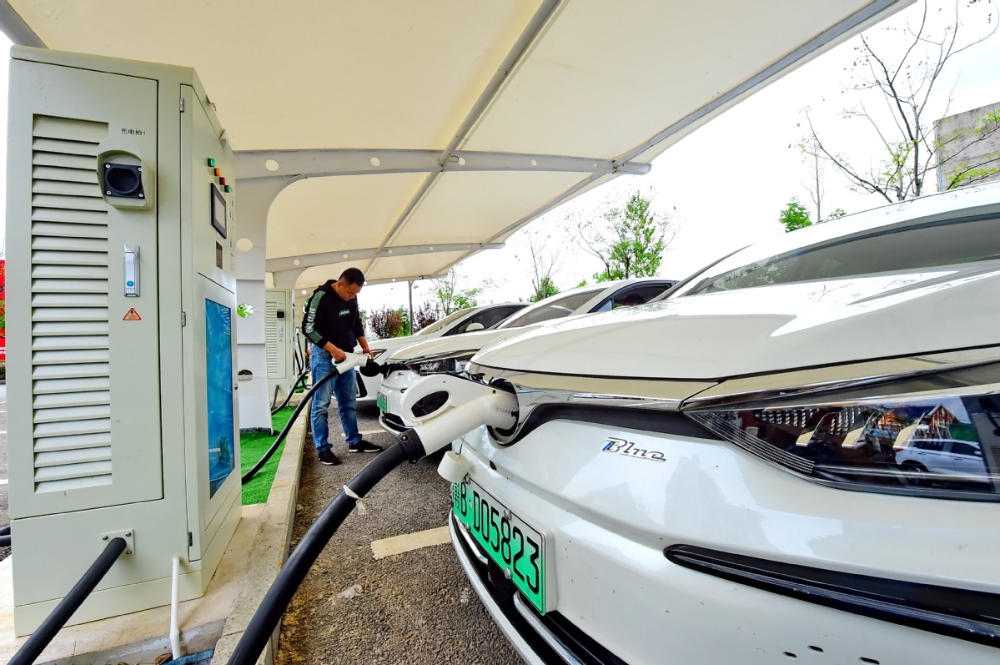from:China Electricity Councildate:2020-06-15

An employee charges electric cars at a charging station in Huichang, Jiangxi province. [Photo by Zhu Haipeng/For China Daily]
New technology to help ensure power stabilization, optimize operating costs
While growth in the electric vehicle market is expected to impose greater demand on the charging grid, electric cars themselves can offer a solution to the issue in the long term, industry insiders said.
The interaction between electric vehicles and the power grid will optimize vehicle operating costs while contributing to a more sustainable electricity system over the long run, a report by industry association China EV100 and the Natural Resources Defense Council said.
The vehicle-to-grid technology and infrastructure, also known as V2G, allows vehicle batteries to return the power to the grid when demand is high to ensure grid stabilization. Not only will grid operators save significant costs in upgrading infrastructure to embrace the electric vehicle time, EV drivers can also be paid when they charge their vehicles.
Introducing V2G charging leads to a more efficient network while saving billions of investment to increase power capacity. The advantages will be more obvious in the long term, Natural Resources Defense Council analyst Jin Hengmei said.
Battery cost still remains high in China at the moment, and the amount of vehicles capable of sharing their batteries with the power grid and two-way charging piles are limited, making it difficult for motorists to get involved with the V2G, Jin said.
At this time, industry insiders believe smart charging will play a major role to help mitigate the increased demand resulting from EV charging, particularly during the evening peak hours.
Liu Jian, a deputy researcher with the Energy Research Institute of the National Development and Reform Commission, suggested utilizing time-of-use prices and demand response programs to encourage coordination between the power grid and electric vehicles in the short and medium term.
EV aggregators should be encouraged to carry out business model innovations which can spur collaboration between EV users and the power grid. The government should also provide financial support to V2G related infrastructure deployment, Liu said.
China's EV charging service market is expected to create an industry worth 2.2 billion yuan ($315.9 million) by the end of 2020, the Natural Resources Defense Council said.
The boom in China's EV charging service sector is taking place against the backdrop of the government extending its financial support to the operation of charging stations.
Liu said the government should encourage electric vehicles to further participate in electric power market transactions to lower charging expenses and increase the consumption of variable renewable energy in long term.
The council suggests the government set a clear entry condition for the participants of V2G and come up with more policy stimulus and financial support, along with clarifying revenue-sharing methods of EV manufacturers, motorists and grid operators.
The council said the price incentive has a direct and clear effect for EV motorists. The government should further improve the incentive mechanism to enhance the potential of private charging piles.
The warranty and insurance of V2G batteries should also be improved to build a more efficient and flexible network that does not require billions in investments and provides a huge uplift in capacity.
Some 10 years of V2G projects worldwide have proved the feasibility of the technology. But issues including setting up a sustainable commercial model, charging pile hardware technology and the high cost of V2G charging piles still need to be tackled, the council said.
Charging piles for electric vehicles were included for the first time in China's initiative of new infrastructure development in the country's government work report, released on May 22 at the third session of the 13th National People's Congress.
This will help the new energy vehicle charging pile industry to make up for its shortcomings by using digital and intelligent technologies.
A development plan for the NEV industry issued by the Ministry of Industry and Information Technology last year estimated that there will be a gap of 63 million charging piles in China over the next 10 years. It is expected to create a market worth 1.02 trillion yuan.
Kou Nannan, head of China research with Bloomberg New Energy Finance's advanced transport sector, said V2G usually relies on progress in local power market reforms, so it is not available to all provinces at this stage.
"EVs are also more concentrated in eastern coastal provinces, and that's why Beijing and Shanghai are leading V2G trails, while other provinces either do not have a large fleet size nor the pain of evening power demand peak," Kou said.
"EV owners are also worried about battery degradation caused by V2G. It is not clear if automakers will still provide the same kinds of warranty if the EVs participate in V2G applications."
Kou believes EV charging by sequence is more of a headache for grid companies.
"As EV fleets rise, the charging burden to the local gird, especially in old resident areas, will become more apparent, and they have been pushing it with more efforts now," he said.
Tel:+86-25-84152563
Fax:+86-25-52146294
Email:export@hbtianrui.com
Address:Head Office: No.8 Chuangye Avenue, Economic Development Zone, Tianmen City, Hubei Province, China (Zip Code: 431700) Nanjing Office: Room 201-301, Building K10,15 Wanshou Road,Nanjing Area, China (Jiangsu) Pilot Free Trade Zone,Jiangsu Province,China (Zip Code:211899)
